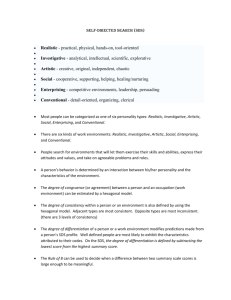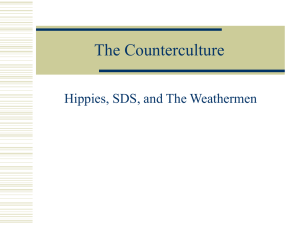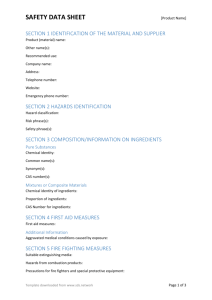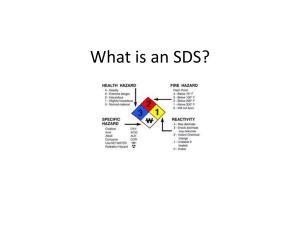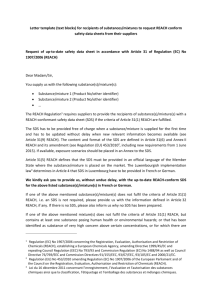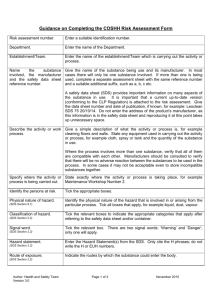Regional Partnership Alliance to Combat Sand and Dust Storms 1
advertisement
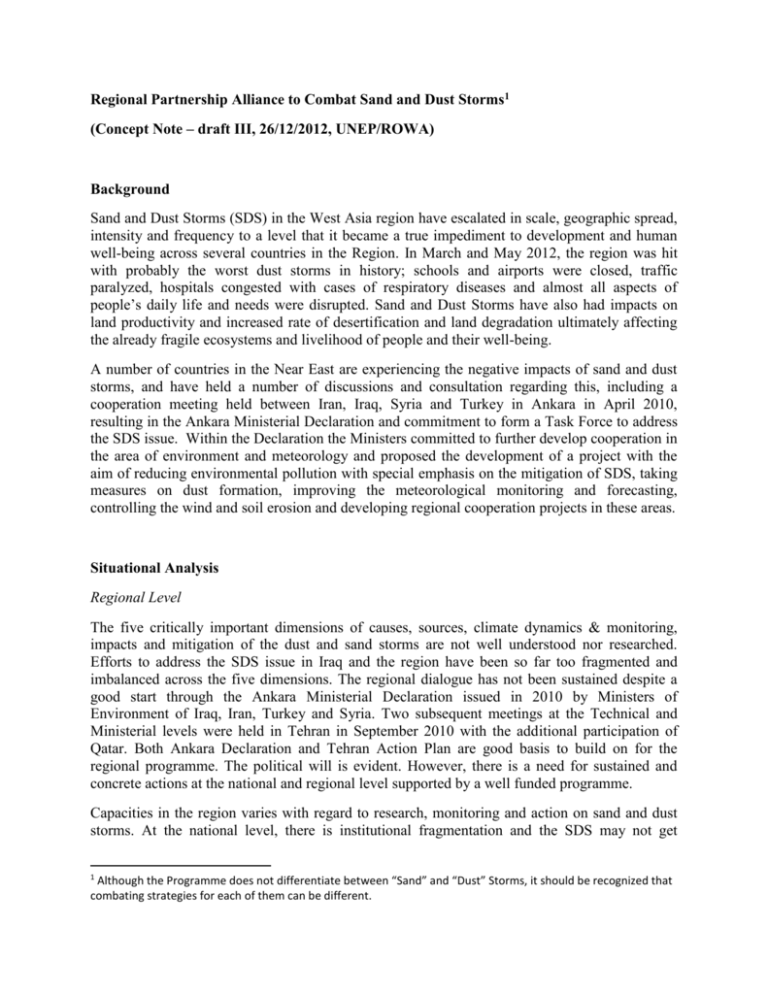
Regional Partnership Alliance to Combat Sand and Dust Storms1 (Concept Note – draft III, 26/12/2012, UNEP/ROWA) Background Sand and Dust Storms (SDS) in the West Asia region have escalated in scale, geographic spread, intensity and frequency to a level that it became a true impediment to development and human well-being across several countries in the Region. In March and May 2012, the region was hit with probably the worst dust storms in history; schools and airports were closed, traffic paralyzed, hospitals congested with cases of respiratory diseases and almost all aspects of people’s daily life and needs were disrupted. Sand and Dust Storms have also had impacts on land productivity and increased rate of desertification and land degradation ultimately affecting the already fragile ecosystems and livelihood of people and their well-being. A number of countries in the Near East are experiencing the negative impacts of sand and dust storms, and have held a number of discussions and consultation regarding this, including a cooperation meeting held between Iran, Iraq, Syria and Turkey in Ankara in April 2010, resulting in the Ankara Ministerial Declaration and commitment to form a Task Force to address the SDS issue. Within the Declaration the Ministers committed to further develop cooperation in the area of environment and meteorology and proposed the development of a project with the aim of reducing environmental pollution with special emphasis on the mitigation of SDS, taking measures on dust formation, improving the meteorological monitoring and forecasting, controlling the wind and soil erosion and developing regional cooperation projects in these areas. Situational Analysis Regional Level The five critically important dimensions of causes, sources, climate dynamics & monitoring, impacts and mitigation of the dust and sand storms are not well understood nor researched. Efforts to address the SDS issue in Iraq and the region have been so far too fragmented and imbalanced across the five dimensions. The regional dialogue has not been sustained despite a good start through the Ankara Ministerial Declaration issued in 2010 by Ministers of Environment of Iraq, Iran, Turkey and Syria. Two subsequent meetings at the Technical and Ministerial levels were held in Tehran in September 2010 with the additional participation of Qatar. Both Ankara Declaration and Tehran Action Plan are good basis to build on for the regional programme. The political will is evident. However, there is a need for sustained and concrete actions at the national and regional level supported by a well funded programme. Capacities in the region varies with regard to research, monitoring and action on sand and dust storms. At the national level, there is institutional fragmentation and the SDS may not get 1 Although the Programme does not differentiate between “Sand” and “Dust” Storms, it should be recognized that combating strategies for each of them can be different. priority among other pressing political and development issues. Coordinated and complimentary approaches are necessary to ensure a regional wide effectiveness in addressing the problem. The Proposed Cooperation Programme Purpose Statement The purpose of the Programme is to trigger systematic and step-wise collaboration among SDSaffected countries based on informed and science-based sustained actions to reduce the occurrence, mitigate and control the SDS at the source, transportation paths and the deposition areas. Equally important, these actions should be accompanied by solid scientific research and actions on the causes, trends and prediction, morning, early warning and preparedness measures. Programme Objective Sand and Dust storms have had profound impacts through all dimensions of socio-economic and development of the countries. During the blow of the sand and dust storm, life is almost paralyzed resulting in loss of productivity and businesses, higher demand for water and power, damage to infrastructure and constraints on public health services in addition to large scale land degradation and desertification and loss of the potential that ecosystems provide in the form of goods and services. The ultimate goal of the Programme is to protect people, environment and development of the region and countries from the threats and impacts of sand and dust storms. This goal will be achieved through the following four inter-linked objectives: Objective 1 - To strengthen cooperation among countries of the region (and within countries) to address the SDS problem through collaborative and innovative solutions, institutions and adequate resources Objective 2 - To enhance scientific and societal knowledge about the causes, sources, impacts, dynamics of and coping with the SDS Objective 3 - To reduce occurrence and impacts of SDS through the design and implementation of innovative and scalable solutions that will at the same time promote investment in the green economy benefiting local communities and their livelihoods Objective 4 - To establish systems of coordinated and state-of-the art monitoring and early warning including development of specialized regional centres Programme Approach and Design The Programme will be built in a logical step-wise approach as shown in figure 1 below. The approach includes four major steps: Understand & diagnose the problem Propose and get Consensus of the Solution Implement The Agreed Actions Monitor, Learn and Scale Up Understanding and Diagnosing the Problem For any effective and sustainable programmatic intervention there is a need to understand the problem, its root causes, impacts and the best and most cost-effective strategies to counter it. Although the SDS problem has been known to impact the region for decades, there is still limited scientific understanding of its causes, sources and dynamics. Nor we know the existing scientific potential of countries in the region to investigate the problem in more depth. Historical records are dispersed among national and global research and government institutions. There is limited sharing of data, information and knowledge among countries. Therefore, the first step is to conduct a special assessment of the SDS phenomena, identify the gaps and propose solutions. Propose and Get Consensus of the Solution During the Special Assessment phase, scientists, policy experts and technical staff from relevant institutions would have the opportunity to debate viable solutions based on experiences and practices existing in the region and elsewhere (especially the far east, China, Mongolia, Japan and South Korea). This process will lead to the elaboration of a comprehensive medium to long term programme to combat dust storm. The Key component of this programme will be the regional cooperation platform which will facilitate regional dialogue and pave the way for collaborative action initiatives on the scientific and research fronts as well as on the government institutions fronts. Consensus among the countries on the programme is the key to its success. Implement Agreed Actions Once the regional medium and long-term programme agreed and the provisional cooperative framework at the regional level is set up, the programme will be implemented at the regional and country level according to well defined Action Plans. Actions at the country level will be the responsibly of the country itself. The focus will be on the hot spots identified in the Assessment phase. The programme will encourage innovative solutions with strong participation from local governments, communities and civil society organizations. The private sector and financial institutions will be the principle partners to support these actions. At the regional level, the focus will be on inter-county collaboration on applied research, information exchange and networking, capacity building and an overarching monitoring programme linked to global SDS monitoring systems. Monitor, Learn and Scale Up To sustain action and have long term impacts, it is necessary to establish a system to measure success, to learn from experience and to define and implement carefully tailored strategies for scaling up of these actions. The regional platform with elements such as the Regional SDS Fund or SDS Facility and the associated knowledge networks will be the core functional institution to operate this phase. Programme Components The Programme is organized into eight components corresponding to the four major steps described above. These components are structured in such a modular way whereby they can be tailored to be implemented at the regional, sub-regional and national level or any combination of these levels. Description of the Programme Components A. Special Assessment of SDS Objective: To assess the state of knowledge with regard to SDS physical phenomenon, its occurrence, impacts and state of capacities within the region to deal with it. Outputs: 1. Assessment Report on historical trends, transportation paths, causes and impacts and recommendations on potential intervention measures 2. Illustrative maps of hot spots areas 3. A set of indicators related to SDS and extremes 4. Enhanced capacities in the region on conducting such assessments 5. Assessment of information/knowledge gaps and elaborated components for a comprehensive programme Process: The assessment will be undertaken by a multi-disciplinary team of international and regional scientists and collaborating centres. It will be based on comprehensive literature review on SDS studies, questionnaires, focus group discussions, country-level information gathering, remote sensing information and observed data. The global and regional circulation/climate models with dust storm elements will be used to the extent possible. Hotspots and areas of vulnerability due to land use practices, climate change, climate variability and extreme events will be identified. B. Regional Cooperation Framework Objective: the objective here is to build in gradual way a sustainable regional mechanism to enhance cooperation among affected countries. Outputs 1. 2. 3. 4. 5. 6. MoU or Framework Agreement among countries Task Force on SDS Advisory Committee on SDS Thematic Expert Groups as necessary Network of Research Institutions Interim Secretariat for the Partnership/Programme (or Programme Management Unit) Process: The framework will be built up gradually. It will start by establishing expert groups at the technical level to exchange information/knowledge and assist with the Special Assessment. As the issue is understood better and the value and nature of cooperation among countries become apparent, more involvement at the policy level will be encouraged through regional meetings, capacity building activities and possibly an MoU in follow up to the Ankara Declaration. An interim Secretariat will be established in UNEP for the purpose of facilitating such process C. Research, Measurement & Assessment Objective: To enhance the understanding on SDS phenomenon based on accurate measurements and regular assessment Outputs 1. Regional and Local Climate Models linking climate, drought, water, soil and land use parameters 2. Measurement instruments and stations 3. Focused and prioritized and strategic applied research studies 4. Simulation of the proposed mitigation processes and evaluation of results 5. Collaboration on Research within the Region and with global centres of excellence 6. Regular assessment of the SDS based on the initial assessment Process: A research programme will be developed based on priorities stemming out of the Special Assessment. A system of SDS measurement and monitoring stations linked to other relevant programme components such as the monitoring and early warning. Complementary capacities for climate modeling will be established across the countries of the region. Climate modeling will include simulation of potential mitigation measures and the likely effect on reducing SDS. This will help in the design of the most effective mitigation measures at the local/site level. The research will be very focused on areas that are major sources of dust to establish the baseline and thereafter measure progress towards achieving the objective of the programme. D. Innovation & Knowledge Network Objective: To promote sharing of knowledge and information among partners within the region and with global knowledge networks and to attract creative ideas and technological innovations (mainly indigenous) to tack the SDS problem. Outputs 1. 2. 3. 4. Knowledge Hub Network of Experts, Institutions and Focus Groups Web-based Platform Communication and Outreach Process: The Innovation and Knowledge Network will be built gradually from the core expert group that is established during the Special Assessment phase. The core group will contribute to the full design of the Network. The network will be a combination of virtual and physical hubs. It will be opened for regional and international institutions. Specialized centres will be assigned to lead particular aspect(s) of the SDS. At least one annual meeting of the Network will be held and an International SDS Conference will be held every two years. E. Monitoring & Early Warning System Objective: To develop a Regional Atmospheric Watch (Dust Watch) and Early Warning System linked to the global WMO Sand and Dust Storm Warning Advisory and Assessment System (SDS-WAS) Outputs 1. Regional SDS Monitoring and Early Warning Centre similar to that of the Asian and Mediterranean centres established under the auspices of the WMO 2. Early Warning Systems at the national level (either new dedicated to SDS or established within existing national systems) 3. SDS Indices 4. Training and capacity building Process: The starting point for this component is the assessment of existing monitoring and observation systems in the regional and global wise to improve and support network monitoring and observation current stations to monitor aerosol, pollutants and dust in the atmosphere and on the land's surface. The System will be linked to the national drought, desertification, extreme weather events, air quality systems, as appropriate. The System will allow speedy and real-time exchange of data and information to alert countries on SDS with more accuracy on the characteristics of the storms so that appropriate precautionary measures are put in place. F. Facility or Fund Objective: The Trust Fund or Facility to be established to ensure sustainability of programme implementation and predictability of financial resources. The Fund will facilitate a mechanism whereby countries in the region can support research collaboration and projects across affected countries. Outputs 1. Trust Fund Establishment Agreement detailing rules, procedures and accountability of the Trustee and partners at large 2. A Financial Support Group 3. Programme Innovation Facility (to assist countries with coming up with innovative projects to be implemented at the local level) Process: The Trust Fund will be established in conjunction with reaching an agreement on regional cooperative framework to combat sand and dust storms. The Board of Trustee will be composed of country representatives and contributors to the fund. Funds will be disbursed according to the rules, procedures and priority programmatic actions. As a provisional/temporary arrangement, UNEP will establish a project account to facilitate transition from the development phase to the implementation and trust fund phase. The B G. Country Action Plans Objective: To combat SDS at the source area through mitigation, control and remediation measures at the source and affected areas Outputs 1. 2. 3. 4. National/Local Assessments of SDS National Action Plans to combat SDS Implementable Local Level Projects Project Design Templates and Packages categorized based on types of mitigation technologies Process: The Action Plans will be based on local-level assessment of SDS causes, sources, etc. The assessment will lead to better design of the most appropriate and effective mitigation options. A number of focused projects in hotspot areas to reduce dust and sand storms will be designed and implemented. Depending on the scale of funding, the start up phase could include pilot/demo projects. The results of these projects should be evaluated to assess effectiveness and to scale up successful demonstrations. H. Green Investments Objective: Designing and implementing green investment projects to test different mitigation technologies and assess their effectiveness and impacts. An integrated community- and ecosystem-based management approach will be promoted to improve livelihoods and alleviate poverty in the affected areas. Additionally, a strategy to encourage scaling up of successful projects through private sectors and local governments will be implemented Outputs Process: I. Country-Level Action Network Objective: The objective of the action network is integrating combating SDS into national policies, programmes and plans. It will link science to policy and action and to build institutional capacities at the national and local levels. Outputs 1. National network of experts and institutions to support national programme and to feed into the regional one 2. Capacity building programmes 3. Effective policy measures across sectors to address root causes 4. National SDS research and observatory (e,g. Atmospheric Watch, Monitoring, Early Warning, etc) The following diagram illustrate the Programme Design and its components Implementation Approaches The Programme should be designed in such a way that it can be scaled up or down as resources become available. It should also allow for partners and stakeholders with various interests to join. The implementation of the Programme will be driven by countries themselves through the established institutions. For purpose of coordination and management of the Programme especially at the initial stage, a Programme Management Unit or Interim Secretariat will be establish and temporary hosted by UNEP. At the regional level, the execution of Programme activities at the initial phase will be the responsibility of UNEP but with under the oversight of the advisory committee or the Task Force The following elements will be necessary to achieve successful implementation of the Programme: a) Regional Task Force on SDS b) Scientific (Technical) Advisory Group The Group can be constituted from experts well known in the field and are affiliated to worldknown research institutions with long experience with dust issues. The Group will aim to pull scientific knowledge and transfer to the regional counterparts through joint research activities, regular assessments, international, regional and national conferences. c) Networks of Institutions and Experts d) Climate or SDS Trust Fund (or Facility) The Trust Fund or Facility can be established to ensure sustainability of programme implementation and predictability of financial resources. The Fund will facilitate a mechanism whereby countries in the region can support research collaboration and projects across affected countries. Role of Partners: Partner Governments Programme Development Policy guidance Establishing the baseline and advise on linkages with government policy, programmes and plans including budgeting Programme Implementation Provide funding and resources, oversee implementation, execute relevant part of the programme, provide linkages with government policy, programmes Programme Monitoring Critical role for the governments and stakeholders Research Institutions Regional Organizations International Organization Private Sector and plans Provide technical input and support national institutions in execution of activities Provide technical input and support national institutions in execution of activities Support programme implementation bringing up technical expertise and global experiences Baseline information, exchange of ideas for better programme design Baseline information, exchange of ideas for better programme design Initiate programme development, serve as interim for a for inter-governmental dialogue, coordination and problem solving Contribute to the Investment in green project design from innovations the financial sustainability perspectives Resources Requirements: The programme can be funded and implemented in three sequential phases to scale up activities as the programme establish itself and propel. Stage 1 (securing funding, essential activities, 3 years time) Programme Component Estimated Cost of the Stage US $3-5 M What the stage will Good understanding of the identifying result in (Impacts) problem, knowledge gaps, cooperation among countries mainly at the technical and research level, nucleolus facilitation mechanism (interim secretariat), large scale partnership programme developed and round table for resources mobilization Stage 2 (medium budget, pilot and scalable activities, 5 years) Stage 3 (high budget, full implementation and large investment components) US $ 10-20 M US $ >20M In-depth understanding of the problem, its impact and comprehensive region-wide approach to its solution, knowledge bases, enhanced cooperation of countries through sustained process of reaching consensus and agreeing on actions, facility on dust storm established and operational, specialized and policy networks established, improved SDS management and enhancing livelihoods through implementation of pilot projects, strategy for scaling up the investment In-depth understanding of the problem, its impact and comprehensive region-wide approach to its solution, knowledge bases, enhanced cooperation of countries through sustained process of reaching consensus and agreeing on actions, facility on dust storm established and operational, specialized and policy networks and centres of excellence established/assigned, SDS controlled, mitigated and coping strategies, standard of living upgraded in affected rural and urban areas through large scale green investment projects Special Assessment of SDS 0.5 1.0 1.0 Regional Cooperation Framework 0.5 1.5 3.0 Research, Measurement & Assessment 0.5 2.0 3.0 Innovation & Knowledge Network 1.0 2.0 5.0 5.0 5.0 – 10.0 0.5 1.0 2.0 0.5 1.0 2.0 10.0 >10 Monitoring & Warning System Early Facility or Fund Country Action Plans Green Investments Country-Level Network Action 1.0 2.0 2.0 0.5 1.0-2.0 3-5 US $ 3-5 M US $10-20 M US $>20 M Programme Management Estimated Total Possible Implementation Partners & Funding Sources Programme Component Special Assessment of SDS Regional Cooperation Framework Research, Measurement & Assessment Innovation & Knowledge Network Monitoring & Early Warning System Facility or Fund Country Action Plans Green Investments Country-Level Action Network Programme Management Government sources UN System Regional Financial Institutions and Funds incl. Private sector Regional Organizations International Financial Institutions and Funds & Bilaterals Timeframe Action Concept Finalization Consultations with Governments & Interested Partners Establishing the Expert Group Elaborating the Programme Design Document Fund Mobilization for the formulation of the programme document Securing Approval & signatures of countries Programme Inception phase Y1 Y1 Y2 Y2 Y3 Y3 Y4 Y5 >Y5 Programme Implementation Mid-Term Review of the Programme Programme Phase completion

